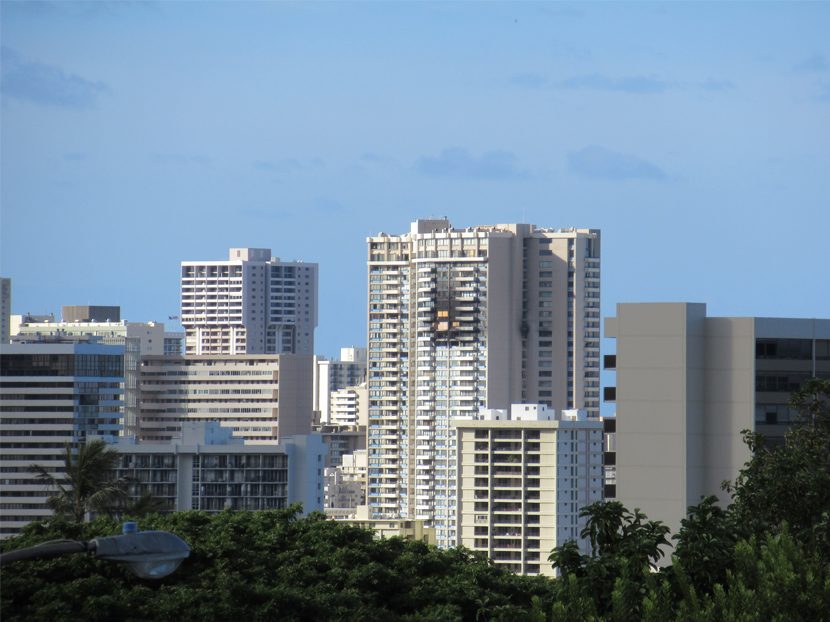The Marco Polo Fire
What we know about the building and one of the largest fires in history.

On July 14, 2017, a fire occurred in the Marco Polo Condominium, 36-story, high-rise building, resulting in three deaths and more than $100 million in direct fire losses.
The Marco Polo is located at 2333 Kapiolani Blvd., on the Mauka (mountain) side of the Ala Wai canal, about one mile from Waikiki Beach.
It was built in 1971; the Honolulu Building Code at the time was based on the 1967 edition of the Uniform Building Code (UBC).
The primary building occupancy was Group H (hotels and apartments), and the UBC construction type was Type I. The building has 36 stories, and the height is approximately 340 feet.
The following building information was taken from the original construction drawings.
The primary structure consisted of reinforced concrete beams and columns, a concrete floor slab and concrete shear walls. The interior corridor construction was one-hour fire-resistive. A substantial amount of the corridor walls, including coincident shaft walls, consisted of gypsum wall board partitions. Some dwelling unit separation walls were concrete; most were gypsum wallboard partitions consisting of one layer of 5/8 inch gypsum wallboard on either side of metal studs.
The doors between the dwelling units and the interior corridor were 1-3/4-inch solid wood core doors. It is noted that the 1967 UBC did not require self-closing devices on the doors between dwelling units and the corridor, however, it appears these doors were provided with closing devices.
Corridors on each floor had access to one of three enclosed exit stairs. The center stair was designed as a smoke-proof enclosure, with an open-air vestibule between the corridor and the stair. The 1967 UBC only required one exit to be a smoke-proof enclosure.
Stair enclosures were provided with doors with a 90-minute fire protection rating.
It was reported in the media that there were several units that modified the door to the corridor by installing jalousie louvers. There were other reports that some units installed “security” screen doors in front of the main door, and propped the main door open for ventilation (1). Whether or not this condition contributed to the rapid fire extension on the upper floors has not been confirmed. Unconfirmed fire department reports indicate that wind was a factor in this fire.
With the exception of the trash chutes, the building was not equipped with automatic sprinklers. The trash chute access rooms and chutes were provided with sprinklers connected to the domestic plumbing system. As an existing high-rise condominium, the Marco Polo was not required by the Honolulu building or fire codes to have complete automatic sprinkler protection.
The building had a manual dry standpipe system, with standpipe risers and hose connections located in the Ewa (west) and Diamond Head (east) stairwells. The center stair did not have a dry standpipe riser, nor was it required by the 1967 UBC, which required buildings four stories or more in height to be equipped with not less than one dry standpipe and an additional standpipe for each additional ten thousand square feet (10,000 square feet) or fraction thereof. The two dry standpipes were not interconnected, as was also permitted by the 1967 UBC.
A Class II (occupant use) standpipe system was provided with fire hose cabinets located throughout the corridors. It was reported (unconfirmed) that firefighters attempting to use the fire hose cabinets experienced boiling hot water being discharged from the nozzles.
The original building fire alarm system consisted of manual fire alarm stations and alarm bells in the corridors. Elevator lobbies were equipped with smoke detectors. There was no emergency voice communication system, nor was one required by the building code for existing high-rise condominiums.
Dwelling unit smoke alarms are required for existing condominiums and are permitted to be battery-operated.
The fire is reported to have started early Friday afternoon, July 14. Honolulu Fire Department (HFD) spokesman Capt. David Jenkins reported (2) the fire started in Apartment Unit 2602, on the 26th floor. This unit is located on the Ewa end of the Mauka side (northwest side) of the building, very close to the Ewa exit stair.
At the time of this writing, the exact fire cause has not been determined, but HFD investigators have ruled out arson and cooking as causes.
From Unit 2602, the fire extended into the corridor and eventually to upper floors through interior penetrations.
It has been reported that the fire breached gypsum wallboard corridor partitions in several locations. Photographs and video of the fire show large amounts of smoke issuing from the top of various shaft openings on the roof.
The fire also extended into units directly above from the exterior after having broken glass windows and balcony doors. As seen from the many photographs on the web, the fire “leapfrogged” to at least three units above the unit of fire origin.
Several occupants of the building reported they were unable to hear the fire alarms system (3).
Three people died, and five people, including one firefighter, were seriously injured. The three fatalities in this fire were a women, age 71, found in Unit 2615, and a man, age 54, and woman, age 87, both found in Unit 2613. These two apartments were located directly across the corridor from Unit 2602 on the Makai (south) side of the building.
The fire damaged more than 200 of the buildings 562 dwelling units, forty of which were “completely destroyed.”
The HFD called seven alarms during the fire which was attended by over 120 firefighters and 15 engines and trucks.
The Honolulu Fire Department has reported a preliminary damage estimate of at least $100 million(4). By the time the insurance companies and army of attorneys get done with litigation, and indirect losses are tallied, the estimate will be much greater.
By comparison, according to the Honolulu Fire Department, for the 10-year period between 2006 to 2015, Honolulu fire losses in high-rises were approximately $5 million, $4.6 million of which was in non-sprinklered high-rises(5). The Marco Polo direct fire loss dwarfs this figure by comparison, and is easily the largest single-building fire loss in Honolulu history.
Given the apparent ease and speed in which this exterior leapfrogging occurred, it may have been fortunate that the fire did not start on a much lower floor.
Also, the human cost of this fire could have been very different if the fire started when most of the apartment dwellers were home and asleep, and not on a Friday afternoon where occupants tend to be awake and may be out of the building.
Honolulu has more than 300 existing residential high-rise buildings that are not provided with sprinkler protection. High-rise sprinkler requirements came in to the Honolulu Building Code in 1975 with the adoption of the 1973 edition of the UBC.
In the immediate aftermath of the fire, there have been calls from “concerned” politicians to update the fire safety of existing high-rise condominiums with retrofit legislation to include complete automatic sprinkler protection and updated fire alarm systems.
The Honolulu Fire Department has actively advocated for the retrofit of sprinklers and other fire safety features into existing high-rise buildings for many years. The politicians, the Honolulu City Council in particular, had their chance in 2005 and decided not to approve a bill to require retrofit of condos.
More on the aftermath of the Marco Polo fire in next month’s column.
Footnotes:
1. Marco Polo’s homeowners flout fire law with doors, officials say, Rob Perez, 7/26/2017, Staradvertiser.com
2. Fire investigators determine unit where Marco Polo fire originated, Rosemarie Bernardo, July 18, 2017, Staradvertiser.com
3. Marco Polo high-rise had outdated fire alarms, Associated Press, July 28, 2017
4. Marco Polo fire caused more than $100 million in damage, Staradvertiser.com, August 1, 2017
5. No Sprinkler Systems, More Costly Damage in Oahu High-Rises, Rob Perez, Staradvertiser.com, July 23, 2017
SFPE Notes: The call for Extended Abstracts has been announced for the Fire Engineering Solutions for the Built Environment, The 12th International Conference on Performance Based Codes and Fire Safety Design Methods, Hilton Hawaiian Village, Oahu, Hawaii April 23-27, 2018. Extended abstracts are due October 15, 2017. For more info go to sfpe.org





